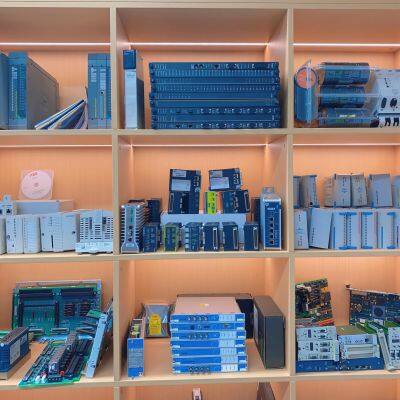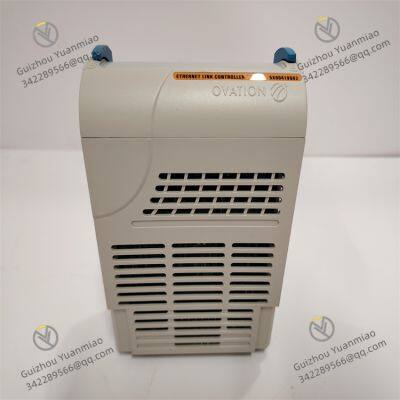Product Description
I. Overview
EMERSON 5X00419G02 is an important industrial control module, belonging to the Ovation control system series. In the field of industrial automation, it mainly undertakes key tasks such as data processing, signal conversion and transmission, and serves as an important bridge connecting on-site equipment and control systems.
With Emerson's advanced technology and rich experience in the industrial control field, this module features high reliability, high precision and strong adaptability. It can operate stably in many industrial scenarios such as electric power, chemical industry and metallurgy, providing strong support for the automatic control of industrial production processes and ensuring the efficient and safe operation of production systems.

II. Technical Parameters
Signal Processing: It supports various types of input signals, including analog signals (such as 4-20mA current signals, 0-10V voltage signals, etc.) and digital signals, which can meet the signal acquisition needs of different on-site equipment. It has high processing accuracy for input signals. The measurement accuracy of analog signals can usually reach ±0.1% of full scale, and the response time of digital signals is short, which can quickly and accurately capture changes in signal status.
Communication Interfaces: It is equipped with standard communication interfaces, such as Ethernet interfaces and serial communication interfaces (RS-485, etc.), and supports a variety of mainstream industrial communication protocols, such as Modbus and TCP/IP. It is convenient for data interaction and communication with upper computers, other control modules or on-site intelligent equipment, realizing real-time information sharing and centralized management.
Power Requirements: It adopts DC power supply, with a typical working voltage of 24VDC, and the allowable voltage fluctuation range is usually ±10% to adapt to slight fluctuations of power supply voltage in industrial sites. The power consumption in normal working state is low, generally ranging from several watts to more than ten watts, which will not bring too much burden to the system power supply.
Working Environment: It has a wide working temperature range, usually able to work stably between -40℃ and 70℃, and can adapt to harsh temperature environments such as high and low temperatures in industrial sites; the relative humidity is in the range of 5% - 95% (no condensation), with certain moisture-proof ability; at the same time, it has strong anti-electromagnetic interference ability and can run reliably in the complex electromagnetic environment of industrial sites.
Physical Characteristics: It adopts a compact design with small size, which is convenient for installation in industrial control cabinets and saves installation space. The shell is made of industrial-grade materials, with certain anti-vibration and anti-impact performance, meeting the mechanical environment requirements of industrial equipment.
III. Functional Features
High-Precision Data Acquisition and Processing: It can accurately collect various signals of on-site equipment, and perform rapid processing and conversion to convert them into digital signals recognizable by the control system. Whether it is the slight change of analog signals or the instantaneous state of digital signals, it can accurately capture and process them, providing accurate original data for the control system and ensuring the accuracy of control decisions.
Flexible Expandability: As part of the Ovation control system, this module can be flexibly matched and expanded with other modules in the system (such as I/O modules, control modules, etc.). Users can conveniently increase or decrease the number of modules according to actual control needs, build control systems that meet different scales and functional requirements, and have strong adaptability and expandability.
High Reliability and Stability: It uses industrial-grade components and strict production processes, and has undergone long-term reliability testing and verification, enabling it to work stably in harsh industrial environments. It is equipped with a perfect self-diagnosis function, which can monitor the operating status of the module in real time. When a fault occurs, it can send out an alarm signal in time, facilitating maintenance personnel to quickly troubleshoot and handle, and improving the availability of the system.
Convenient Integration and Debugging: Following industry general standards and specifications, it can be seamlessly integrated with Emerson Ovation control system and other mainstream industrial control systems, reducing the difficulty and cost of system integration. It is equipped with special debugging software and tools with a user-friendly interface and simple operation, enabling engineers to quickly complete parameter configuration and fault diagnosis of the module, and shortening the system debugging cycle.

IV. Common Faults and Solutions
Abnormal Signal Acquisition
Fault Phenomenon: The collected signal is inaccurate, there is no signal, or the signal fluctuates greatly, resulting in the control system being unable to normally obtain the status information of on-site equipment.
Possible Causes: Fault of on-site sensors, resulting in abnormal output signals; damage, poor contact of signal transmission lines or strong electromagnetic interference; fault of the signal processing circuit of the module.
Solutions: First, check the on-site sensors, use standard instruments to detect the sensors to confirm whether they work normally, and replace them in time if there is a fault. Check the signal transmission lines, see if there is damage or disconnection, re-plug the connectors to ensure good contact. For interfered lines, shielding measures can be taken or shielded cables can be replaced. If all the above checks are normal, it may be a fault of the module's signal processing circuit, and it is necessary to contact professional maintenance personnel for repair or replacement of the module.
Communication Fault
Fault Phenomenon: The module cannot establish a communication connection with the upper computer or other equipment, or data loss, transmission errors, etc. occur during communication.
Possible Causes: Loose or damaged communication interfaces; incorrect configuration of communication protocol parameters (such as mismatched baud rate, IP address, port number, etc.); communication lines are interfered or too long, leading to signal attenuation.
Solutions: Check the communication interfaces to ensure that the connectors are plugged in tightly without looseness or damage, and replace the communication interfaces if necessary. Recheck the communication protocol parameters to ensure they are consistent with those of the communicating counterpart equipment. For communication lines, check if the lines are too long and if they are far away from strong electromagnetic interference sources. If necessary, shorten the line length or add signal amplifiers, repeaters and other equipment to enhance signal strength.
Module Failure to Start
Fault Phenomenon: After the module is powered on, there is no response, the indicator light is not on, and it cannot enter the normal working state.
Possible Causes: Power supply failure, such as power supply voltage not within the specified range, open circuit or poor contact of power lines; damage to the power interface of the module; internal circuit fault of the module.
Solutions: Check the power supply, use a multimeter to measure whether the power supply voltage meets the working requirements of the module, check whether the power lines are connected firmly and whether there is an open circuit, and replace the power supply if necessary. Check the power interface of the module, and repair or replace the interface in time if damage is found. If both the power supply and the interface are normal, it may be an internal circuit fault of the module, and it is necessary to contact the manufacturer or professional maintenance organizations for repair or replacement of the module.


WOODWARD BUM60-1224-54-B-001-VC-A0-0093-0013-G003-000 Controller
GE VPROH2B IS215VPROH2BC Emergency Turbine Protection Card
GE DS2020PDMAG6 Power Distribution Module
GE IS200AEPCH1ABC Crucial Printed Circuit Board
GE IS210MACCH2AEG Printed Circuit Board
GE IS210MACCH1AGG Single-Axis Motion Control Module
GE IS210MACCH2AGG Analog Output Module
GE IS200AEPCH1BAA Circuit Board
GE IS200AEPAH1ACB Printed Circuit Board
GE IS210BPPBH2BMD Printed Circuit Board
GE IS200AEPAH1AFD Printed Circuit Board
GE DS200UCPBG6AFB I/O Engine CPU Board
 yezi
Hi there! Welcome to my shop. Let me know if you have any questions.
yezi
Hi there! Welcome to my shop. Let me know if you have any questions.




